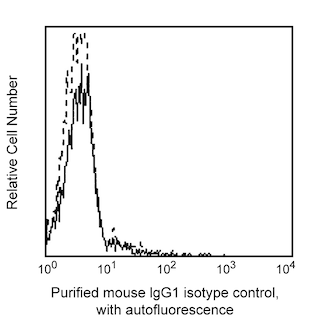Old Browser
This page has been recently translated and is available in French now.
Looks like you're visiting us from {countryName}.
Would you like to stay on the current country site or be switched to your country?




Flow cytometric analysis of Human Neutrophil Elastase expression in the Human U-937 tumor cell line. Cells from the Human Jurkat (Acute T cell leukemia, ATCC® TIB-152™; Left Panel) and Human U-937 (Histiocytic Lymphoma, ATCC® CRL-1593™; Right Panel) cell lines were fixed with BD Cytofix™ Fixation Buffer (Cat. No. 554655), washed and then permeabilized with BD Perm/Wash™ Buffer (Cat. No. 554723). The cells were then stained in BD Perm/Wash™ Buffer with either Purified Mouse IgG1, κ Isotype Control (Cat. No. 554121; Dashed Line Histograms) or Purified Mouse Anti-Human Neutrophil Elastase antibody (Cat. No. 569518; Solid Line Histograms) at 0.5 µg/test. The cells were then secondarily stained with PE Goat Anti-Mouse Ig (Multiple Adsorption) antibody [Cat. No. 550589]. The fluorescence histograms showing Neutrophil Elastase expression (or Ig Isotype control staining) were derived from gated events with the light-scatter characteristics of intact cells. Flow cytometry and data analysis were performed using a BD LSRFortessa™ X20 Cell Analyzer System and FlowJo™ software. Data shown on this Technical Data Sheet are not lot specific.


BD Pharmingen™ Purified Mouse Anti-Human Neutrophil Elastase

Regulatory Status Legend
Any use of products other than the permitted use without the express written authorization of Becton, Dickinson and Company is strictly prohibited.
Preparation And Storage
Product Notices
- Please refer to www.bdbiosciences.com/us/s/resources for technical protocols.
- Since applications vary, each investigator should titrate the reagent to obtain optimal results.
- An isotype control should be used at the same concentration as the antibody of interest.
- Caution: Sodium azide yields highly toxic hydrazoic acid under acidic conditions. Dilute azide compounds in running water before discarding to avoid accumulation of potentially explosive deposits in plumbing.
- Sodium azide is a reversible inhibitor of oxidative metabolism; therefore, antibody preparations containing this preservative agent must not be used in cell cultures nor injected into animals. Sodium azide may be removed by washing stained cells or plate-bound antibody or dialyzing soluble antibody in sodium azide-free buffer. Since endotoxin may also affect the results of functional studies, we recommend the NA/LE (No Azide/Low Endotoxin) antibody format, if available, for in vitro and in vivo use.
- Please refer to http://regdocs.bd.com to access safety data sheets (SDS).
- For U.S. patents that may apply, see bd.com/patents.
Companion Products



.png?imwidth=320)
The NP57 monoclonal antibody specifically recognizes human Neutrophil Elastase (NE) which is also known as Human leukocyte elastase (HLE), Granulocyte-derived Elastase (GE), or PMN Elastase (PMN-E). Neutrophil Elastase is a major serine proteinase encoded by ELANE (Elastase, neutrophil expressed) that belongs to the elastase subfamily within the peptidase S1 family. Neutrophil Elastase is predominantly present in the azurophilic granules (primary granules) of neutrophils and monocytes. When released outside of these effector cells, it can act to hydrolyze a variety of extracellular matrix substrates including elastin, fibronectin, collagen, and proteoglycans. Elastase activity in normally controlled by serine proteinase inhibitors. Neutrophil Elastase can regulate the functions of NK cells, monocytes, and granulocytes, eg, by inhibiting C5a-dependent enzyme release and chemotaxis by neutrophils. It is also capable of killing bacteria such as E. coli and degrading virulence factors from bacteria such as Yersinia, Shigella, and Salmonella. Dysregulated expression or defects in this enzyme are associated with some inflammatory and degenerative diseases including rheumatoid arthritis, emphysema, chronic obstructive pulmonary disease, and cystic fibrosis as well as neutropenias.
Development References (7)
-
Belaaouaj A, Kim KS, Shapiro SD. Degradation of outer membrane protein A in Escherichia coli killing by neutrophil elastase.. Science. 2000; 289(5482):1185-8. (Biology). View Reference
-
Cramer EM, Beesley JE, Pulford KA, Breton-Gorius J, Mason DY. Colocalization of elastase and myeloperoxidase in human blood and bone marrow neutrophils using a monoclonal antibody and immunogold.. Am J Pathol. 1989; 134(6):1275-84. (Clone-specific: Electron microscopy, Immunofluorescence, Immunohistochemistry). View Reference
-
Davies PL, Maxwell NC, Kotecha S, Spiller OB. Monoclonal anti-neutrophil elastase antibody characterisation: ability to block function, detect free versus serpin-complexed enzyme and stain intracellular granules.. J Immunol Methods. 2008; 336(2):175-82. (Clone-specific: Flow cytometry). View Reference
-
Korkmaz B, Attucci S, Jourdan ML, Juliano L, Gauthier F. Inhibition of neutrophil elastase by alpha1-protease inhibitor at the surface of human polymorphonuclear neutrophils.. J Immunol. 2005; 175(5):3329-38. (Biology). View Reference
-
Pulford KA, Erber WN, Crick JA, et al. Use of monoclonal antibody against human neutrophil elastase in normal and leukaemic myeloid cells.. J Clin Pathol. 1988; 41(8):853-60. (Immunogen: Immunofluorescence, Immunohistochemistry, Immunoprecipitation, Western blot). View Reference
-
Tralau T, Meyer-Hoffert U, Schröder JM, Wiedow O. Human leukocyte elastase and cathepsin G are specific inhibitors of C5a-dependent neutrophil enzyme release and chemotaxis.. Exp Dermatol. 2004; 13(5):316-25. (Biology). View Reference
-
Weinrauch Y, Drujan D, Shapiro SD, Weiss J, Zychlinsky A. Neutrophil elastase targets virulence factors of enterobacteria.. Nature. 2002; 417(6884):91-4. (Biology). View Reference
Please refer to Support Documents for Quality Certificates
Global - Refer to manufacturer's instructions for use and related User Manuals and Technical data sheets before using this products as described
Comparisons, where applicable, are made against older BD Technology, manual methods or are general performance claims. Comparisons are not made against non-BD technologies, unless otherwise noted.
For Research Use Only. Not for use in diagnostic or therapeutic procedures.